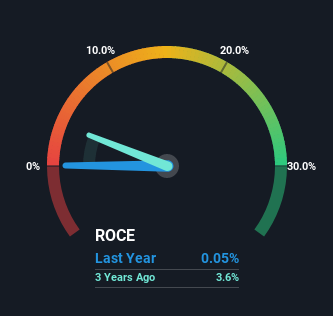- Italy
- /
- Consumer Durables
- /
- BIT:RAD
Some Investors May Be Worried About Radici Pietro Industries & Brands' (BIT:RAD) Returns On Capital
To find a multi-bagger stock, what are the underlying trends we should look for in a business? Firstly, we'll want to see a proven return on capital employed (ROCE) that is increasing, and secondly, an expanding base of capital employed. Put simply, these types of businesses are compounding machines, meaning they are continually reinvesting their earnings at ever-higher rates of return. Although, when we looked at Radici Pietro Industries & Brands (BIT:RAD), it didn't seem to tick all of these boxes.
Understanding Return On Capital Employed (ROCE)
For those that aren't sure what ROCE is, it measures the amount of pre-tax profits a company can generate from the capital employed in its business. To calculate this metric for Radici Pietro Industries & Brands, this is the formula:
Return on Capital Employed = Earnings Before Interest and Tax (EBIT) ÷ (Total Assets - Current Liabilities)
0.00046 = €24k ÷ (€70m - €18m) (Based on the trailing twelve months to December 2021).
So, Radici Pietro Industries & Brands has an ROCE of 0.05%. In absolute terms, that's a low return and it also under-performs the Consumer Durables industry average of 12%.
View our latest analysis for Radici Pietro Industries & Brands

Above you can see how the current ROCE for Radici Pietro Industries & Brands compares to its prior returns on capital, but there's only so much you can tell from the past. If you'd like to see what analysts are forecasting going forward, you should check out our free report for Radici Pietro Industries & Brands.
The Trend Of ROCE
When we looked at the ROCE trend at Radici Pietro Industries & Brands, we didn't gain much confidence. Over the last four years, returns on capital have decreased to 0.05% from 7.9% four years ago. Meanwhile, the business is utilizing more capital but this hasn't moved the needle much in terms of sales in the past 12 months, so this could reflect longer term investments. It's worth keeping an eye on the company's earnings from here on to see if these investments do end up contributing to the bottom line.
On a related note, Radici Pietro Industries & Brands has decreased its current liabilities to 25% of total assets. So we could link some of this to the decrease in ROCE. Effectively this means their suppliers or short-term creditors are funding less of the business, which reduces some elements of risk. Since the business is basically funding more of its operations with it's own money, you could argue this has made the business less efficient at generating ROCE.
What We Can Learn From Radici Pietro Industries & Brands' ROCE
Bringing it all together, while we're somewhat encouraged by Radici Pietro Industries & Brands' reinvestment in its own business, we're aware that returns are shrinking. And in the last year, the stock has given away 43% so the market doesn't look too hopeful on these trends strengthening any time soon. On the whole, we aren't too inspired by the underlying trends and we think there may be better chances of finding a multi-bagger elsewhere.
Since virtually every company faces some risks, it's worth knowing what they are, and we've spotted 3 warning signs for Radici Pietro Industries & Brands (of which 2 are significant!) that you should know about.
For those who like to invest in solid companies, check out this free list of companies with solid balance sheets and high returns on equity.
New: AI Stock Screener & Alerts
Our new AI Stock Screener scans the market every day to uncover opportunities.
• Dividend Powerhouses (3%+ Yield)
• Undervalued Small Caps with Insider Buying
• High growth Tech and AI Companies
Or build your own from over 50 metrics.
Have feedback on this article? Concerned about the content? Get in touch with us directly. Alternatively, email editorial-team (at) simplywallst.com.
This article by Simply Wall St is general in nature. We provide commentary based on historical data and analyst forecasts only using an unbiased methodology and our articles are not intended to be financial advice. It does not constitute a recommendation to buy or sell any stock, and does not take account of your objectives, or your financial situation. We aim to bring you long-term focused analysis driven by fundamental data. Note that our analysis may not factor in the latest price-sensitive company announcements or qualitative material. Simply Wall St has no position in any stocks mentioned.
About BIT:RAD
Radici Pietro Industries & Brands
Engages in the production and distribution of woven and non-woven textile coverings worldwide.
Undervalued with excellent balance sheet.
Market Insights
Community Narratives



